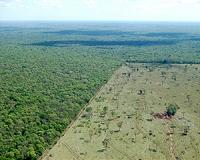 |
London, UK (SPX) Sep 10, 2010 By studying similarities in the genes of Scots Pine trees, scientists have shown that the iconic pine forests of Highland Scotland still carry the traces of the ancestors that colonised Britain after the end of the last Ice Age, harbouring genetic variation that could help regenerate future populations, according to new results published in the journal Heredity. The research was carried out by an international team from the Centre for Ecology and Hydrology, the Polish Academy of Sciences, the University of Edinburgh and the Macaulay Land Use Research Institute. Today's Scots Pine forests are remnants of the ancient, much larger Caledonian forest that covered the northern parts of Britain from the end of the last Ice Age until many trees were lost due to over-exploitation and agriculture more than 400 years ago. It has previously been thought that as the trees were lost so was much of the genetic diversity contained within them. Without sufficient genetic diversity the remaining pine tree populations may not be able to adapt and survive under new conditions, for example as the climate changes. By studying the remnant Scottish populations the researchers were able to see how much genetic variation remains and also how these trees compare to the intact Scots Pine forests of continental Europe and Asia. The good news is that Scottish populations turn out to be at least as genetically diverse as their continental cousins. This suggests that despite the huge losses they have suffered, the last fragments of the Caledonian Pine forest in Scotland still harbour genetic variation that could help regenerate future populations. "Despite its Scottish image, the Scots Pine owes much to its European roots." said paper co-author Dr Stephen Cavers, an ecologist based at the Centre for Ecology and Hydrology's Edinburgh site, "By looking at the trees' DNA we have learnt much about how the forests grew up after the Ice Age. Given the severe fragmentation of the current population, our results are key to understanding how these forests will cope with future change." Where the genetic diversity comes from is another question. Given the great age that these trees can reach - as much as 700 years in some cases - the forests present today may be no more than a few tens of generations removed from the first migrants to reach these shores after the ice retreated. DNA evidence suggests that these early arrivals came in two waves: one, which reached the far north-western Highlands very soon after the ice retreated, possibly via Ireland, and another, which settled in the eastern Highlands, from central Europe. Dr Cavers added, "We plan to continue the study, to try and discover if there are particular genes which let the Highland trees tolerate the harsh Scottish climate."
Share This Article With Planet Earth
Related Links Centre for Ecology and Hydrology Forestry News - Global and Local News, Science and Application
 Most New Farmland Comes From Cutting Tropical Forest
Most New Farmland Comes From Cutting Tropical ForestStanford CA (SPX) Sep 09, 2010 Global agricultural expansion cut a wide swath through tropical forests during the 1980s and 1990s. More than half a million square miles of new farmland - an area roughly the size of Alaska - was created in the developing world between 1980 and 2000, of which over 80 percent was carved out of tropical forests, according to Stanford researcher Holly Gibbs. "This has huge implications for g ... read more |
|
| The content herein, unless otherwise known to be public domain, are Copyright 1995-2010 - SpaceDaily. AFP and UPI Wire Stories are copyright Agence France-Presse and United Press International. ESA Portal Reports are copyright European Space Agency. All NASA sourced material is public domain. Additional copyrights may apply in whole or part to other bona fide parties. Advertising does not imply endorsement,agreement or approval of any opinions, statements or information provided by SpaceDaily on any Web page published or hosted by SpaceDaily. Privacy Statement |